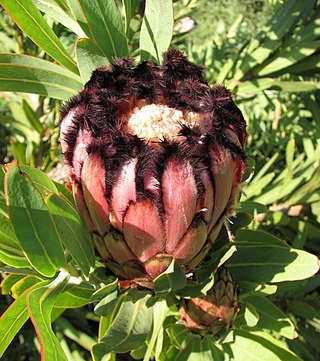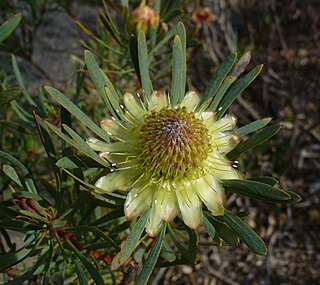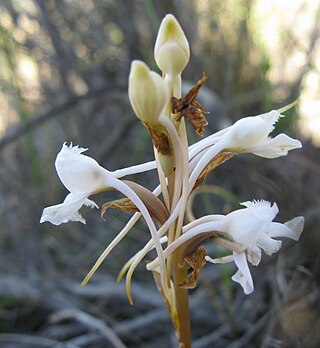
Cape York Peninsula is a peninsula located in Far North Queensland, Australia. It is the largest wilderness in northern Australia. The land is mostly flat and about half of the area is used for grazing cattle. The relatively undisturbed eucalyptus-wooded savannahs, tropical rainforests and other types of habitat are now recognised and preserved for their global environmental significance. Although much of the peninsula remains pristine, with a diverse repertoire of endemic flora and fauna, some of its wildlife may be threatened by industry and overgrazing as well as introduced species and weeds.

Table Mountain National Park, previously known as the Cape Peninsula National Park, is a national park in Cape Town, South Africa, proclaimed on 29 May 1998, for the purpose of protecting the natural environment of the Table Mountain Chain, and in particular the rare fynbos vegetation. The park is managed by South African National Parks. The property is included as part of the UNESCO Cape Floral Region World Heritage Site.

Protea neriifolia, also known as the narrow-leaf sugarbush, oleander-leaved sugarbush, blue sugarbush, or the oleanderleaf protea, is a flowering plant in the genus Protea, which is endemic to South Africa.

Protea laurifolia, also known as the grey-leaf sugarbush, is a shrub from South Africa. It is native to the Cape Provinces of South Africa.

The wildlife of South Africa consists of the flora and fauna of this country in southern Africa. The country has a range of different habitat types and an ecologically rich and diverse wildlife, vascular plants being particularly abundant, many of them endemic to the country. There are few forested areas, much savanna grassland, semi-arid Karoo vegetation and the fynbos of the Cape Floristic Region. Famed for its national parks and big game, 297 species of mammal have been recorded in South Africa, as well as 849 species of bird and over 20,000 species of vascular plants.

Protea scolymocephala, also known as the thistle protea or thistle sugarbush, is a flowering plant from the genus Protea native to South Africa.

Disa bracteata, also known as the bract disa, leek orchid or the South African weed orchid is a species of orchid native to South Africa.

Satyrium coriifolium is a species of orchid endemic to the Cape Provinces. It is commonly known as the orange satyre or Ewwa-trewwa in Afrikaans.

Aloiampelos commixta is a flowering plant in the Asphodelaceae family. It is commonly called Table Mountain aloe, and is a rare succulent plant that is endemic to the Cape Peninsula, South Africa. It naturally occurs only on the Table Mountain range, within the city of Cape Town.

Peninsula Sandstone Fynbos is a unique and endangered vegetation type that is endemic to the Cape Peninsula in Cape Town. This type of Mountain Fynbos occurs on very poor, acidic soils but is incredibly rich in biodiversity with an enormous number of plant species – many of which occur nowhere else. Due to its poor soils and steep, inaccessible location, it has not been developed for farming or houses, and consequently it is relatively well conserved.

Aloe pearsonii is a very distinctive and unusual species of aloe, that is naturally endemic to the arid Richtersveld area on the border between South Africa and Namibia.

Diastella is a genus containing seven species of flowering plants, commonly known as “silkypuffs”, in the protea family. The name comes from the Greek diastellein “to separate”, with reference to the free perianth lobes – the plants are distinguished from the closely related and similar leucospermums by the possession of four free perianth segments. The genus is endemic to the Cape Floristic Region of South Africa where it has a very limited range and is associated with fynbos habitats. The species are all small shrubs. Most species are threatened.

Protea acaulos, also known as the common ground sugarbush, is a flowering plant found in the southwestern Cape Region, South Africa. It is also simply known as ground protea; in the Afrikaans language it is known as an aardroos.

Satyrium membranaceum is a species of ground orchid endemic to south and western Cape Province. It is a more gracile plant than most Satyriums, and the inflorescence is less dense than those of species such as Satyrium coriifolium or Satyrium carneum. Local populations of Satyrium membranaceum vary in colour from nearly red to pure white.

The marine ecoregions of the South African exclusive economic zone are a set of geographically delineated regions of similar ecological characteristics on a fairly broad scale, covering the exclusive economic zone along the South African coast.

The Marine biodiversity of South Africa is the variety of living organisms that live in the seas off the coast of South Africa. It includes genetic, species and ecosystems biodiversity in a range of habitats spread over a range of ecologically varied regions, influenced by the geomorphology of the seabed and circulation of major and local water masses, which distribute both living organisms and nutrients in complex and time-variable patterns.

Protea scabriuscula, also known as the hoary sugarbush or gray sugarbush, is a flowering shrub, endemic to the southwestern Cape Region of South Africa.
The Biodiversity of South Africa is the variety of living organisms within the boundaries of South Africa and its exclusive economic zone. South Africa is a region of high biodiversity in the terrestrial and marine realms. The country is ranked sixth out of the world's seventeen megadiverse countries, and is rated among the top 10 for plant species diversity and third for marine endemism.

Lebeckia plukenetiana is a species of flowering plant in the genus Lebeckia. It is endemic to the Western Cape of South Africa.

Athanasia quinquedentata, or the fivetooth kanniedood, is a species of plant from South Africa.






















